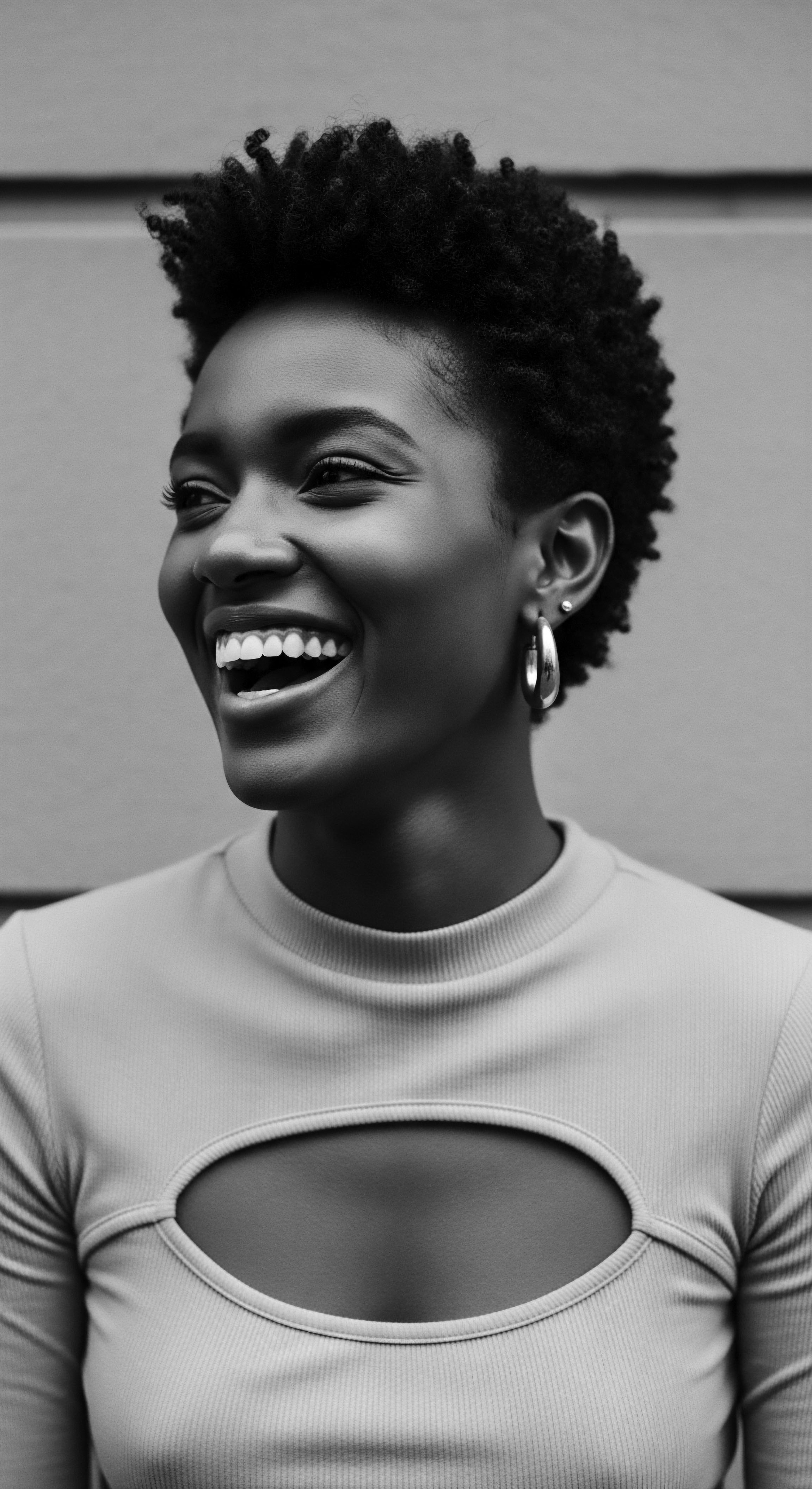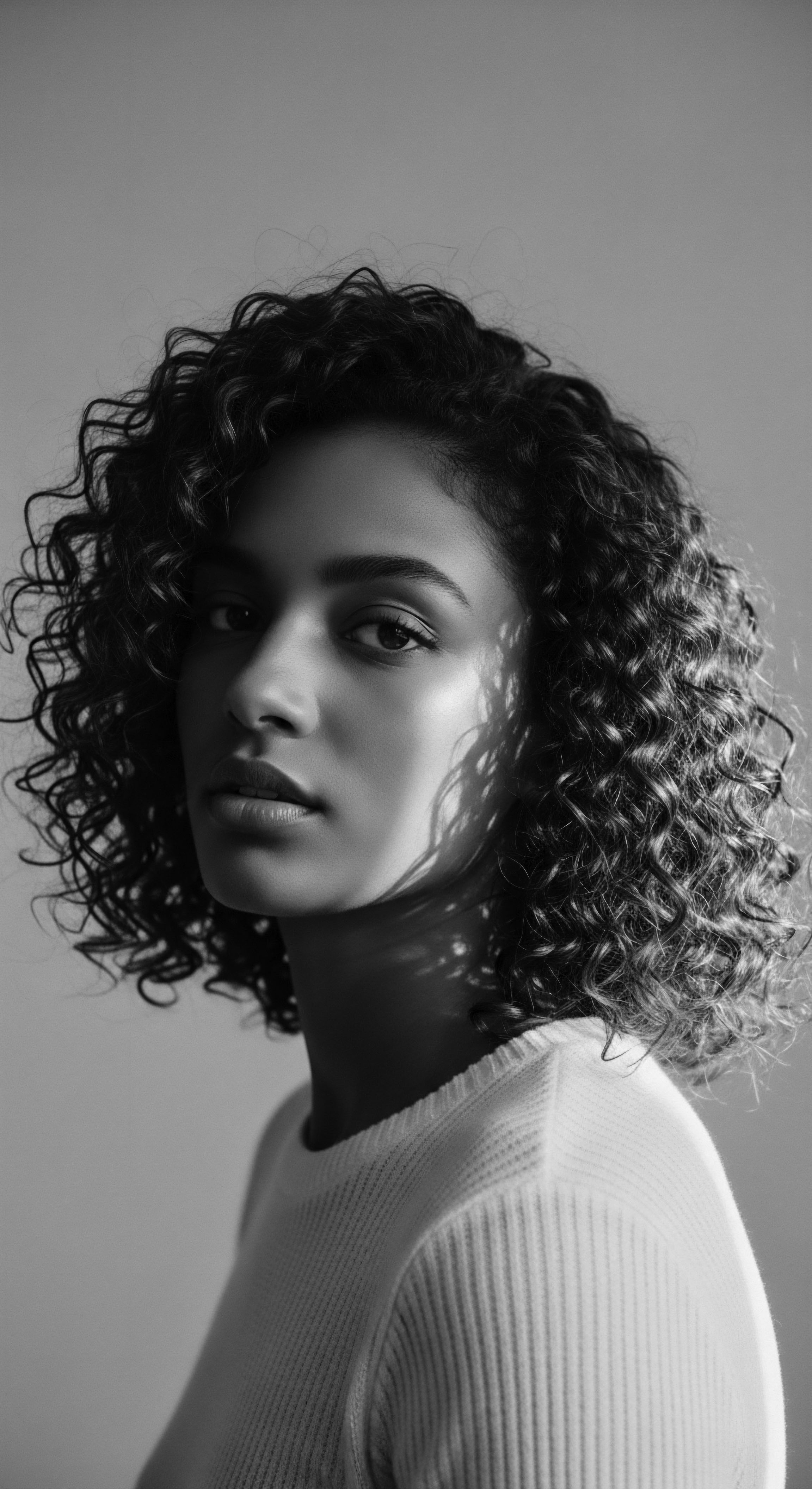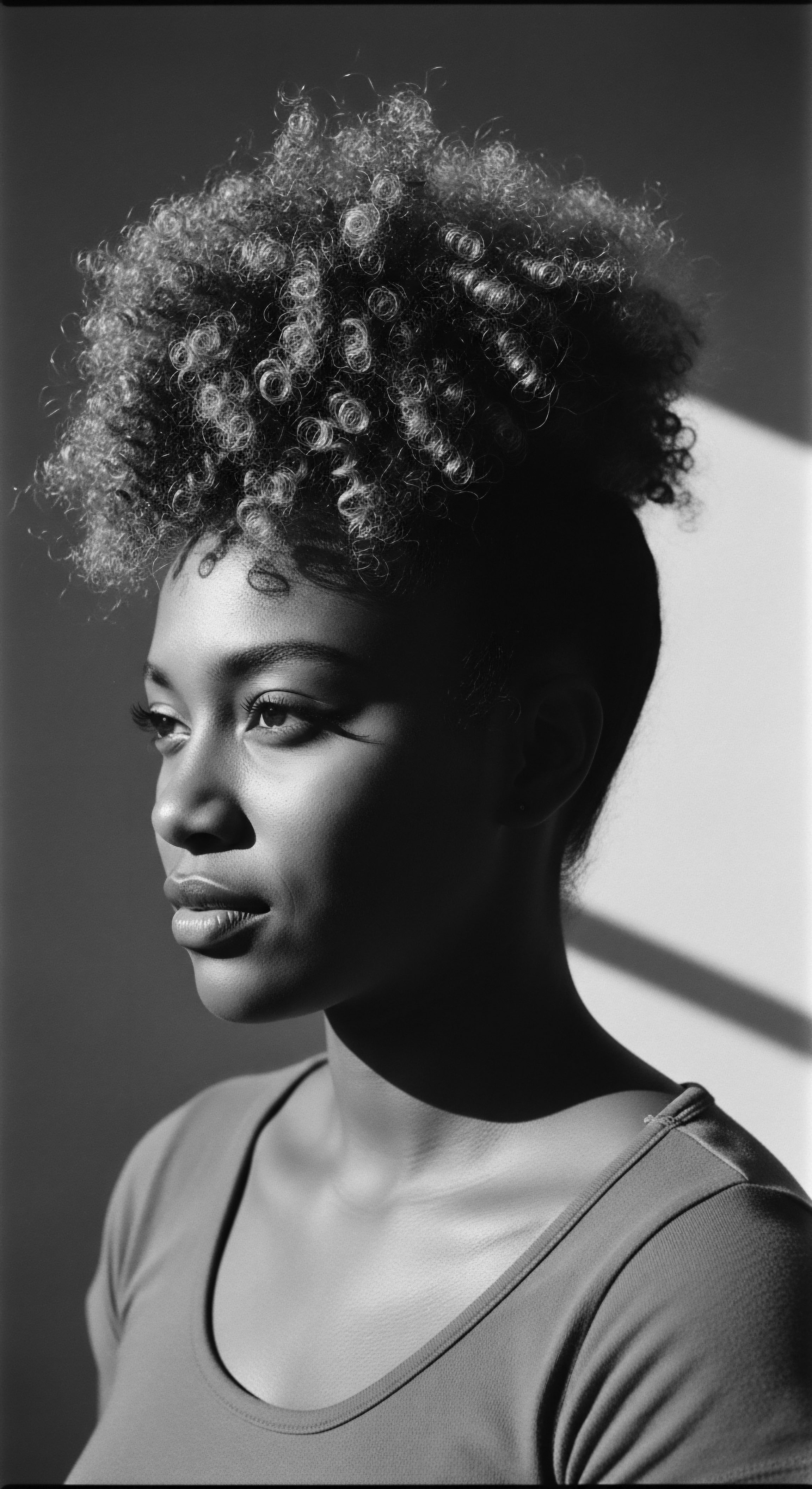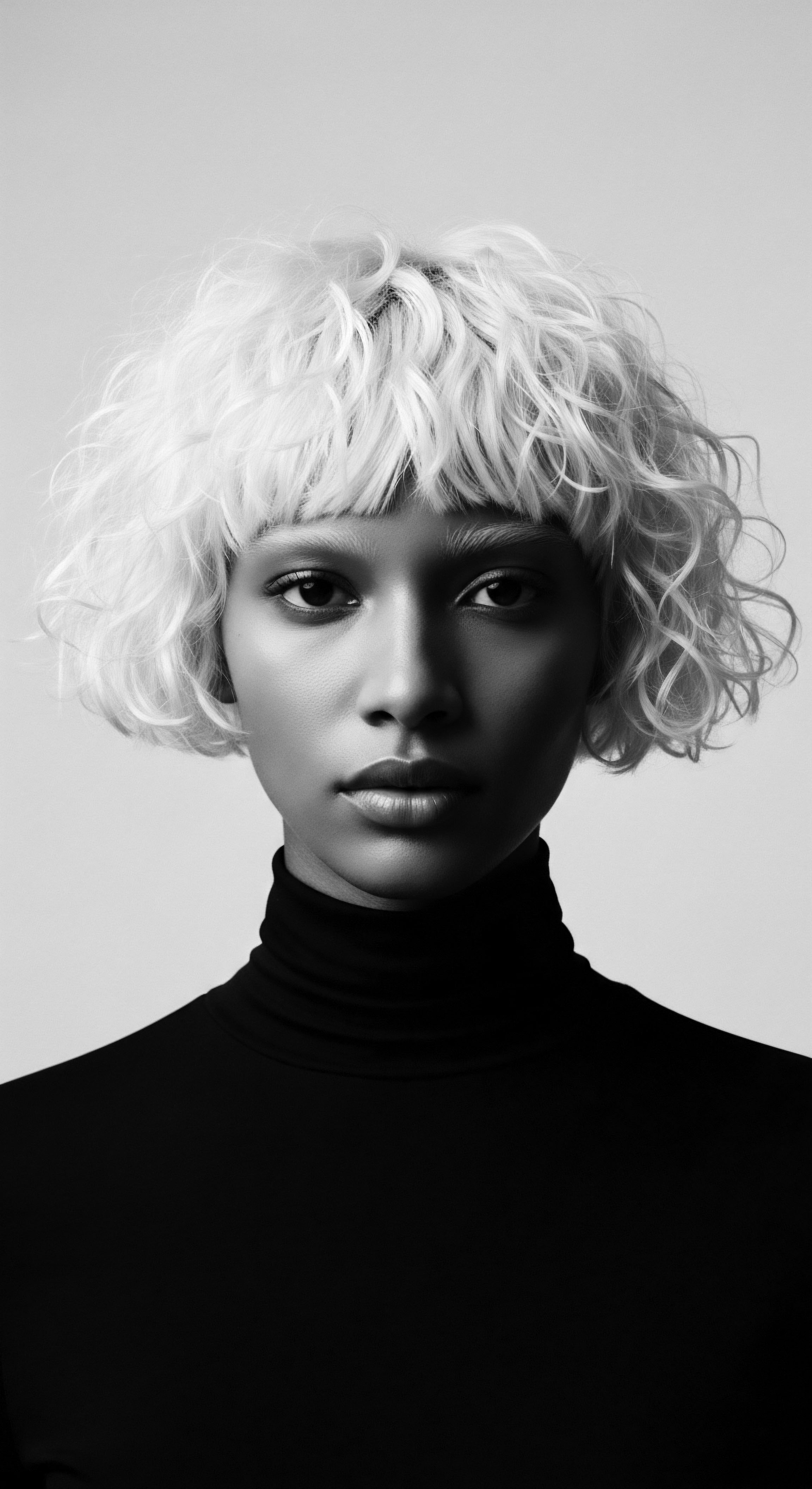
Fundamentals of Textured Hair ❉ Echoes from the Source
In the vast, interconnected ‘living library’ of Roothea, the designation of Textured Hair holds a significance far beyond mere biological classification. It represents a profound cultural lineage, a resilient identity, and a vibrant testament to ancestral wisdom. At its most elemental, textured hair refers to hair strands that deviate from a straight pattern, exhibiting a spectrum of forms including waves, curls, coils, and kinks.
This inherent characteristic, governed by the unique elliptical or flat cross-sectional shape of the hair follicle and the way keratin proteins align, creates the distinct spring and volume that defines it. From a foundational perspective, understanding Textured Hair begins not with a laboratory slide, but with the earth, the sun, and the hands that first nurtured it.
The earliest meaning of Textured Hair is inseparable from the deep historical and cultural contexts of African and diasporic communities. Before the pervasive influence of colonial beauty standards, hair was a revered aspect of self, a potent symbol communicating a person’s social status, heritage, marital standing, age, and even their tribal affiliation. Ancestral communities did not merely view hair as an aesthetic feature; they regarded it as a spiritual conduit, a point of entry for divine energy, linking individuals to their forebears and the spiritual realm. The meticulous processes of washing, combing, oiling, braiding, or twisting, often spanning hours or even days, transformed hair care into a communal ritual, fostering social bonds and serving as a vital means of transmitting cultural traditions from one generation to the next.
The wisdom embedded in these ancient practices formed the bedrock of hair care. Indigenous ingredients, such as Shea Butter from the “sacred tree of the savannah,” were prized for their moisturizing properties, protecting hair and skin from arid climates. The use of natural oils, herbs, and clays was not merely for cosmetic effect; it reflected a deep understanding of botanicals and their therapeutic benefits.
For instance, the use of certain plant extracts for hair growth or scalp health, as documented in ethnobotanical studies, highlights an ancestral pharmacopoeia that predates modern scientific validation. These practices were holistic, connecting physical well-being with spiritual and communal harmony.
Textured Hair, at its core, is a living archive of identity and ancestral knowledge, a testament to the enduring wisdom passed through generations.

The Earliest Expressions of Hair Identity
Across diverse pre-colonial African societies, hair styling served as an elaborate language, each coif a declarative statement. Styles varied widely across ethnic groups, each carrying specific meanings. The Yoruba people of Nigeria, for example, crafted intricate hairstyles that symbolized their community roles, while the Himba tribe in Namibia wore dreadlocked styles coated with red ochre paste, symbolizing their connection to the earth and their ancestors. These practices underscore that Textured Hair was never a uniform entity but a diverse canvas for self-expression and communal identification.
- Adornment ❉ Hair was often embellished with beads, cowrie shells, feathers, and metal, transforming it into an expressive art form that told stories of lineage and life events.
- Communication ❉ In West African societies of the 1400s, a person’s hairstyle could convey their social status, marital status, wealth, age, ethnicity, or even their surname.
- Spiritual Connection ❉ Many communities believed the hair, as the highest point of the body, was a direct link to the divine and ancestral spirits, making its care a sacred duty.
This foundational understanding of Textured Hair reminds us that its essence is intertwined with survival, communication, and profound cultural pride. The resilience of these practices, persisting through eras of profound disruption, speaks volumes about the intrinsic value placed upon this unique hair type by its custodians. The ancestral practices were not just about aesthetics; they were about preserving a way of life, a connection to the past, and a hope for the future.

Intermediate Understandings of Textured Hair ❉ The Tender Thread of Living Traditions
Moving beyond its fundamental origins, an intermediate understanding of Textured Hair reveals how its heritage practices have not only endured but also adapted, forming a tender thread that binds generations across the diaspora. This deeper look acknowledges the biological specificities of textured strands while placing them firmly within the continuous, evolving narrative of care and community. The natural curvature of textured hair, whether a gentle wave or a tightly wound coil, results in fewer cuticle layers lying flat against the hair shaft compared to straight hair. This structural characteristic contributes to its propensity for dryness and tangling, necessitating care rituals deeply rooted in moisture retention and gentle handling.
The wisdom of ancestral hair care, though often passed down orally, holds remarkable congruence with contemporary scientific understanding. Traditional practices emphasized emollients, humectants, and protective styling—concepts now validated by modern trichology. For instance, the widespread use of Shea Butter and various plant oils in African communities served to lubricate the hair shaft, seal in moisture, and provide a protective barrier against environmental stressors. These natural ingredients, often harvested and prepared communally, represent a living pharmacopoeia, demonstrating an intuitive grasp of hair’s needs long before chemical compounds were synthesized.

Continuity and Adaptation in Hair Care Rituals
The transatlantic slave trade presented an unprecedented challenge to the preservation of Textured Hair heritage. Stripped of their traditional tools, ingredients, and the communal spaces where hair rituals flourished, enslaved Africans and their descendants were forced to innovate and adapt. Despite the dehumanizing conditions, hair braiding persisted as a powerful act of cultural resistance and preservation.
Enslaved women would braid each other’s hair, incorporating intricate patterns that not only celebrated their lineage but also served as a covert means of communication, sometimes concealing messages or even maps to freedom. This poignant historical example, documented in sources like Lori Tharps and Ayana Byrd’s work, illustrates the profound dual meaning of Textured Hair ❉ a personal attribute and a tool for collective survival (Byrd & Tharps, 2001).
Through eras of profound challenge, the rituals surrounding Textured Hair transformed from mere grooming into profound acts of cultural preservation and quiet resistance.
The term “cornrows,” now widely recognized, emerged during this period, describing the tightly plaited styles that resembled rows of corn in a field. This adaptation reflects both the scarcity of resources and the enduring ingenuity of those who sought to maintain their cultural identity. Hair wrapping, another tradition, helped to keep hair healthy and avoid heat damage, while also symbolizing a person’s tribe or status within society in African villages.
In the post-slavery era, and through periods of systemic discrimination, Textured Hair continued its journey of adaptation. The rise of “hot combs” and chemical relaxers, while often seen as a departure from natural styles, also represented a complex response to Eurocentric beauty standards and the pursuit of economic and social mobility. Yet, even within these adaptations, a desire for healthy hair persisted, often leading to innovative, if sometimes damaging, methods of care. The legacy of these choices, and the societal pressures that shaped them, remain a vital part of the Textured Hair narrative.
| Aspect of Care Ingredients |
| Traditional African Practice (Pre-Colonial) Indigenous plant oils (e.g. Shea, Marula), clays (e.g. Rhassoul), herbs (e.g. Rooibos tea). |
| Adapted Practice (Slavery/Post-Slavery Era) Limited access to traditional ingredients; improvised with available resources like butter, bacon fat, kerosene, or lye for straightening. |
| Aspect of Care Tools |
| Traditional African Practice (Pre-Colonial) Hand-carved combs, pins, razors, natural fibers for adornment. |
| Adapted Practice (Slavery/Post-Slavery Era) Development of "jimcrow" combs, hot combs (Marcel's hot comb popularized by Madam C.J. Walker), later flat irons. |
| Aspect of Care Styling Purpose |
| Traditional African Practice (Pre-Colonial) Identity, status, spirituality, communication, communal bonding. |
| Adapted Practice (Slavery/Post-Slavery Era) Resistance, survival (e.g. hiding seeds/maps), forced assimilation, later self-expression, and pride movements. |
| Aspect of Care Communal Aspect |
| Traditional African Practice (Pre-Colonial) Hair care as a shared ritual, fostering social bonds and intergenerational knowledge transfer. |
| Adapted Practice (Slavery/Post-Slavery Era) Communal hair care continued, often on Sundays, strengthening bonds amidst oppression. |
| Aspect of Care The evolution of Textured Hair care reflects both the loss of traditional resources and the remarkable ingenuity and resilience of Black and mixed-race communities in preserving their hair heritage. |
The resurgence of the natural hair movement in the mid-20th century, particularly during the Civil Rights Movement, marked a significant reclamation of Textured Hair heritage. The Afro Hairstyle became a powerful symbol of Black pride, activism, and a rejection of Eurocentric beauty standards. This period witnessed a renewed appreciation for natural textures and a conscious decision to reconnect with ancestral aesthetics. It was a declaration of self-acceptance and cultural affirmation, illustrating that the tender thread of tradition, though stretched, had never truly broken.

Advanced Perspectives on Textured Hair ❉ The Unbound Helix of Heritage and Future
From an advanced academic standpoint, the ‘Textured Hair’ is not merely a descriptive term for hair morphology; it stands as a complex bio-cultural construct, a dynamic interplay of genetic predisposition, historical imposition, and persistent cultural reclamation. This designation refers to hair exhibiting a helical or coiled growth pattern, ranging from loose waves to tightly wound z-pattern kinks, characterized by an elliptical to flat cross-sectional follicle shape and a non-uniform distribution of keratin proteins along the shaft. This inherent structure, while lending itself to incredible volume and versatile styling, also presents unique physiological vulnerabilities, such as a higher susceptibility to dryness and breakage due to fewer cuticle layers lying flat, which impedes natural sebum distribution and increases friction between strands.
The profound significance of Textured Hair extends beyond its biophysical properties into the realms of anthropology, sociology, and critical race theory. It represents a living testament to diasporic identity, a tangible link to ancestral homelands, and a contested site of aesthetic and political struggle. The historical imposition of Eurocentric beauty ideals, particularly during the transatlantic slave trade and colonial periods, systematically devalued Textured Hair, often labeling it as “unprofessional” or “unclean”.
This deliberate denigration aimed to strip individuals of their identity and cultural pride, forcing a painful schism between self-perception and inherited physical traits. The persistence of hair discrimination, even in contemporary workplaces and schools, as evidenced by the need for legislative protections like the CROWN Act, underscores the enduring legacy of these historical biases.
One particularly compelling historical example of Textured Hair as a tool for resistance and cultural preservation can be found in the ingenuity of enslaved Africans during the transatlantic slave trade. As noted by historians and cultural scholars, including Ayana Byrd and Lori Tharps in their seminal work, Hair Story ❉ Untangling the Roots of Black Hair in America (2001), some African women, particularly rice farmers from West Africa, braided rice seeds and other grains into their hair before or during the perilous Middle Passage journey. This clandestine act of carrying seeds, hidden within the intricate patterns of their braids, served as a desperate, yet ultimately successful, means of preserving a vital food source and a piece of their agricultural heritage, which they later planted in the new lands of their captivity. This practice transcends mere hair styling; it speaks to the strategic use of hair as a vessel for survival, a living repository of ancestral knowledge, and a profound act of defiance against systematic erasure.

The Anthropological Dimensions of Hair as a Cultural Text
Anthropological studies reveal that hair, especially Textured Hair, functioned as a primary cultural text in pre-colonial African societies. It communicated complex social narratives without spoken words. Each twist, braid, or adornment was a signifier within a sophisticated semiotic system. This intricate non-verbal communication extended to delineating age, marital status, wealth, ethnic identity, and even spiritual beliefs.
The communal act of hair styling, often a multi-hour endeavor, reinforced social cohesion and served as an intergenerational pedagogical space where cultural norms, historical narratives, and practical skills were transmitted. The very structure of the hair, its ability to hold complex patterns, made it an ideal medium for such layered communication.
- Symbolic Cartography ❉ Beyond concealing seeds, specific cornrow patterns were utilized by enslaved individuals to create and share maps, detailing escape routes from plantations.
- Social Markers ❉ In some African cultures, the hairstyle could even reveal a person’s surname, as specific clans maintained unique patterns.
- Ritualistic Significance ❉ The Yoruba, for instance, believed hair to be the most elevated part of the body, and braided hair was thought to send messages directly to the gods.

Scientific Validation and the Reclaiming of Ancestral Care
Contemporary hair science, often termed trichology, is increasingly affirming the empirical wisdom embedded in traditional Textured Hair care practices. The biophysical challenges of Textured Hair—its tendency towards dryness, knotting, and breakage—are now understood through detailed analyses of cuticle integrity, cortical structure, and moisture dynamics. For instance, the traditional use of plant-based oils and butters, such as shea butter and coconut oil, aligns with modern understanding of their occlusive and emollient properties, which help to reduce transepidermal water loss from the scalp and provide lubrication to the hair shaft. Similarly, protective styling, a hallmark of ancestral care, minimizes mechanical manipulation and environmental exposure, thereby reducing breakage, a concept now championed by dermatologists and hair scientists.
Modern trichology increasingly validates the efficacy of ancestral Textured Hair care, bridging scientific understanding with inherited wisdom.
The ethnobotanical studies now emerging, though still scarce in some regions, are systematically cataloging the medicinal and cosmetic applications of plants traditionally used for hair care in Africa. Research identifies species used for alopecia, dandruff, and general hair conditioning, with some exhibiting properties that affect hair growth biomarkers. This academic scrutiny provides a scientific lexicon for practices that have sustained hair health for millennia, offering a powerful counter-narrative to historical dismissals of traditional knowledge.

Long-Term Implications and Future Trajectories
From a corporate and expert perspective, a deep understanding of Textured Hair’s heritage offers unparalleled insights for product development, market strategy, and ethical engagement. Businesses that authentically recognize and honor the cultural significance of Textured Hair, rather than merely treating it as a niche market, stand to build genuine trust and loyalty within Black and mixed-race communities. This means moving beyond superficial product lines to invest in research that respects the unique biological and historical needs of textured hair, perhaps even exploring traditional ingredients and formulations with scientific rigor. The long-term success in this sector hinges on cultural competency, acknowledging the historical trauma associated with hair discrimination, and actively participating in movements that celebrate natural hair.
For researchers and scholars, the unbound helix of Textured Hair presents fertile ground for interdisciplinary inquiry. Future investigations could explore the epigenetics of hair texture and its response to environmental stressors across generations, or delve into the neuro-psychological impact of hair discrimination and the healing power of hair reclamation movements. Analyzing the economic consequences of hair discrimination, such as the disproportionate spending by Black women on hair care products or the barriers to employment, provides a crucial lens for understanding systemic inequities.
Furthermore, studying the revival of traditional hair care practices in the diaspora offers a unique window into cultural resilience, identity formation, and the ongoing negotiation of heritage in a globalized world. The profound connection between hair and identity, forged in ancient times and tested by history, continues to shape personal narratives and collective futures.

Reflection on the Heritage of Textured Hair
The journey through the definition of Textured Hair, from its elemental origins to its advanced theoretical underpinnings, leaves us with a profound sense of reverence for its enduring heritage. It is a story not merely of strands and follicles, but of resilience, identity, and the unbroken chain of ancestral wisdom. The Soul of a Strand ethos, so central to Roothea’s purpose, recognizes that each curl, coil, or wave carries the echoes of countless generations, embodying the stories, struggles, and triumphs of a people. This hair is a living testament to a heritage that refused to be silenced, a beauty that defied imposed standards, and a spirit that continuously found ways to flourish against all odds.
The cultural significance of Textured Hair, deeply woven into the fabric of Black and mixed-race communities, transcends transient trends. It is a source of pride, a medium of communication, and a connection to a rich, vibrant past. The gentle hands that once braided maps to freedom, the communal gatherings where hair became a sacred ritual, and the defiant Afros that proclaimed self-acceptance—all these moments are etched into the very essence of Textured Hair. This understanding invites us to approach textured strands not as a challenge to be tamed, but as a sacred inheritance to be honored, understood, and celebrated.
In cherishing the heritage of Textured Hair, we contribute to a future where its innate beauty and profound cultural value are universally acknowledged and respected. It is a call to recognize the ingenuity of ancestral practices, to support the ongoing reclamation of natural hair aesthetics, and to advocate for a world where every strand is celebrated for the unique story it tells. The narrative of Textured Hair is far from concluded; it is a continuous, evolving saga, with each individual contributing their own chapter to this magnificent, living library.

References
- Byrd, A. & Tharps, L. L. (2001). Hair Story ❉ Untangling the Roots of Black Hair in America. St. Martin’s Press.
- Dabiri, E. (2019). Don’t Touch My Hair. Harper Perennial.
- Gates, H. L. (2016). The African Americans ❉ Many Rivers to Cross. Penguin Press.
- Gordon, L. (2017). Black and Beautiful ❉ The Story of Black Hair. Thames & Hudson.
- Hooks, B. (1992). Black Looks ❉ Race and Representation. South End Press.
- Mohan, R. (2020). Ethnobotany of African Plants ❉ Traditional Uses and Scientific Validation. Academic Press.
- Murrow, W. L. (1969). 400 Years Without A Comb. Black Star Publishers.
- Patton, M. (2006). Twisted ❉ The Dreadlock Chronicles. Amistad.
- Sweet, F. W. (2005). Legal History of the Hair and Wig Industry in the United States. Carolina Academic Press.
- Walker, A. (2000). The World Has Changed ❉ Conversations with Alice Walker. The New Press.
